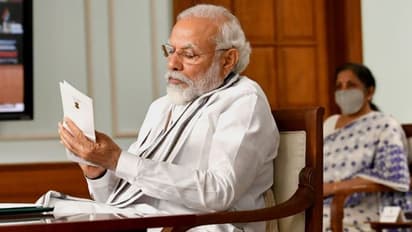Decoding IMF forecast: 'India must be vigilant, hasten reforms'

Synopsis
The policy makers, including the central bank, need to balance the delicate equilibrium between widening fiscal deficit and tightening monetary policy to ensure that the aggregate demand in economy as well as Investor's animal spirit is not destroyed and for that, the key is to hasten economic reforms, say experts
With the International Monetary Fund trimming India's gross domestic product rate at 7.4 per cent for 2022-23, economic experts have suggested that the policymakers need to keep a vigilant eye on the fast-changing and riskier world. To note, in its April estimates, the IMF had projected the Indian economy to grow at an 8.2 per cent rate.
Also Read: IMF cuts India's 2022-23 growth forecast, but will still be among fastest growing economies
Let's understand what the experts have to say:
Prakash Chawla
Economic Expert
Amid global uncertainties and their impact on India with implications on key imports like crude oil, it is no surprise that the IMF has slashed the growth outlook for India by 0.8 percentage points to 7.4 per cent for the current financial year.
Like the rest of the world, particularly in the US and European majors like the UK and Germany, India to is reeling under an elevated level of inflation, forcing the Reserve Bank of India to raise interest rates.
In consonance with the cascading effect into the economic value chain, the high cost of borrowing is bound to hit consumer demand. The industry and the banks which have just about come out of the protracted 'twin balance sheet' problem would be cautious in committing new investments and lendings.
Continuing pressure on the rupee against pressure is also leaving an impact on the cost of essential imports. That leads to further contraction of demand.
However, the situation in India is better relative to other comparable economies, and anything above 7 per cent growth under the given circumstances is not a bad bargain, although we are getting there only after witnessing a big setback in 2020-21 and 2021-22.
Signals from the external sector are not too comforting, even though India has sizeable foreign exchange reserves of about $580 billion. The Ukraine-Russia war will not end soon, making it difficult for net importing countries like India. Some smart moves like direct crude oil imports will have to continue, and exports must be given a leg-up. Export restrictions should be rarely resorted to.
There is also a lurking worry about India's exports of software services. While most top firms, including TCS and Infosys, have not indicated any drop in the deal pipeline, the sentimental impact is visible, at least in the financial markets.
Time to keep a vigilant eye on the fast-changing and riskier world! Reaching the IMF forecast would itself be considered a fair deal.
Shishu Ranjan
Vice President, Barclays
Subsequent to the revision in India's growth rate from 7.8 per cent to 7.2 per cent by the Reserve Bank of India, the International Monetary Fund has also revised their projection for India's growth rate from 8.2 per cent to 7.4 per cent based on the change in the global economic outlook due to ongoing Russia-Ukraine war and potential risk of a global recession.
Even though the IMF considered global economic issues for this downgrade, the real concern for the Indian economy should be the unpredictable monsoon which is expected to result in a slowing agricultural sector, a growth driver in pandemic years.
Climate risk is now real with unexpected heat in London to changing rain patterns in India, which may damage economic growth before nations adjust to the new normal. The growth revision would not have incorporated this risk in revised projections.
The policymakers, including the central bank, need to balance the delicate equilibrium between widening fiscal deficit and tightening monetary policy to ensure that the aggregate demand in the economy and the investors' animal spirit are not destroyed. For that, the key is to hasten economic reforms to reduce cost, improve competitiveness, increase efficiency and reduce bureaucracy to unlock the potential in industrial production.
India's robust internal market has the potential for high growth for decades.
Dr Utsav Kumar Singh
Assistant professor of Economics at Shaheed Bhagat Singh College, University of Delhi
The covid-19 pandemic and the Russia-Ukraine confrontation have continued to affect the economies worldwide. In its report, the IMF has decelerated India’s growth by 80 basis points to 7.4 per cent due to less favourable external factors and more frequent policy tightening.
The high inflation caused due to disruption in the supply chain forced policymakers worldwide to increase the repo rate of federal banks. In the last year, the Reserve Bank of India has raised the repo rate twice in a bid to curb inflation, which is touching the upper bound of 6 per cent.
Spillover impact would dampen the prospect of new ventures. Consequently, the bank will give high interest on people’s deposits in the short term. The new investment in the market would see a diminishing trend. The situation would lead to the creation of stagflation in the economies.
Also Read: India goes shopping for guns, drones, bulletproof jackets worth Rs 28,732 crore
Stay updated with all the latest Business News, including market trends, Share Market News, stock updates, taxation, IPOs, banking, finance, real estate, savings, and investments. Track daily Gold Price changes, updates on DA Hike, and the latest developments on the 8th Pay Commission. Get in-depth analysis, expert opinions, and real-time updates to make informed financial decisions. Download the Asianet News Official App from the Android Play Store and iPhone App Store to stay ahead in business.